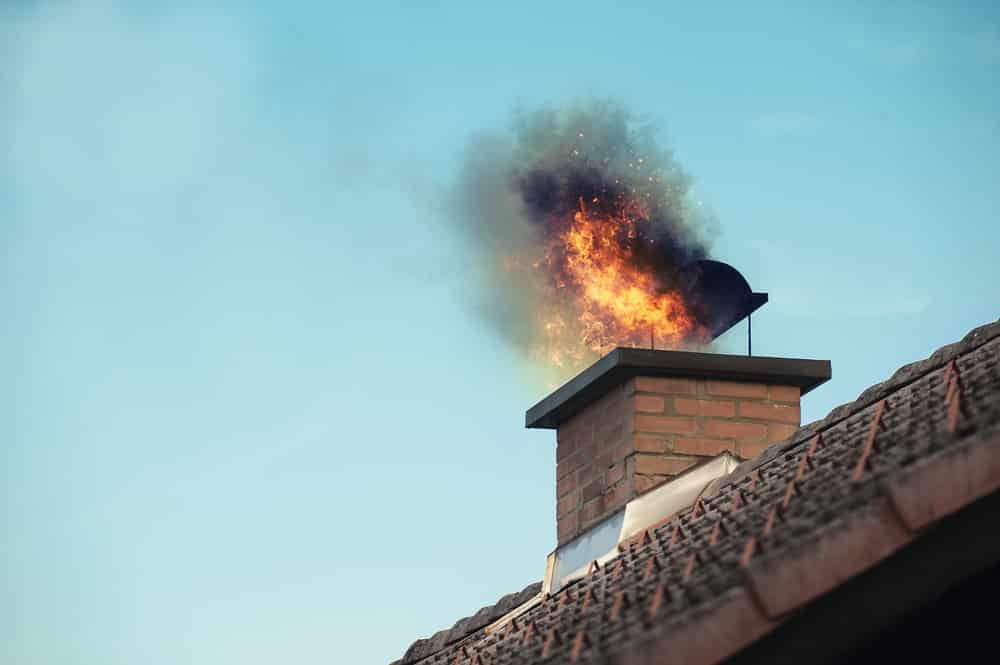The increasing cost of heating fuels has seen many opt to burn wood. While wood fires are warm, cozy, and romantic, they are also one of the biggest causes of a house and chimney fire if one is not cautious. Fireplaces can be pretty safe if closely monitored and maintained by homeowners. One risk often brushed off as that of a chimney fire. But they are also quite hard to notice until the damage is done or it has escalated beyond the house owner’s control.
Below are a few signs that your chimney might catch fire.
- Dense smoke;
- Intense, hot smell;
- Explosive burning;
- Loud popping noises and cracking.
How Can You Prevent a Chimney Fire?
 Use proper fuel
Use proper fuel
Make sure the wood is seasoned and also if possible, go for a hardwood like oak, maple, ash as opposed to softwood. A few logs of greenwood can build creosote thick enough to start a chimney fire.
Proper installation
Your wood stove or furnace must be installed properly and by a professional. This is to ensure the distance between the flammable parts and the non-combustible parts of the heating system. A wood stove’s chimney must be bricks made (masonry) and factory-built. Single bricked chimney with no liner must never be used for a wood stove.
Chimney cleaning
Get a professional chimney sweep to inspect your chimney at least annually, even if you do a DIY. This should be more frequent if the fireplace is lit regularly. You can also DIY your chimney by using a brush and rods to clean the chimney flue and stovepipe once or twice a year. Avoid using heavy stuff such as bricks or chains on the end of a rope. This can easily damage the chimney’s liner. Your chimney will, however, need a monthly inspection by a professional chimney technician if you use a wood stove. For DIY purposes, you can check for creosote buildup in the chimney walls using a mirror.
Ensure there is less or no creosote buildup
Creosote is highly flammable and when it is ignited, burns with vigor. It is formed when vapor from wet wood mixes with gases in the cooler part of the chimney and condenses. Chimney professionals say that a thickness of ¼ inch creosote means your chimney can burst into flames any minute and thus should be removed. In the same breath, do not ignore soot buildup. Soot is softer than creosote, but is equally flammable and should be cleaned up regularly.
Use Smoke Detectors
With the help of smoke detectors, troubleshoot, and take action immediately any time smoke is detected indoors. The smoke is most likely as a result of a dirty chimney full of debris like dead leaves, twigs soot or creosote buildup that have resulted in chimney flue blockage. Other causes include soft or wet wood that has not burned completely or a damper that is not fully opened.
Use Chimney Caps
Your chimney should have a chimney cap with wire mesh to keep out rainwater, ice, snow, and small animals like squirrels, raccoons, and birds from nesting inside the walls. When installing a chimney liner, go for stainless steel. The stainless steel can endure very high temperatures and also keep flying embers contained. Installing fireplace glass-doors that are heatproof can also help increase the efficiency of your heating system. The door prevents heat loss and also shields the embers within the fireplace to stop wild sparkles from reaching your house’s interior. The doors should be cleaned regularly with a glass door cleaner and paper towel.
Proper Ventilation is Really Important
Ventilation is one of the most important parts of your home’s heating system. A huge percentage of chimney fires, safe to say 90%, is caused by faults within the venting system. Take note that the venting system is not the same as the chimney system. The venting system consists of a stovepipe that connects the burning stove to the chimney. Most importantly, we cannot reiterate enough the need for a clean chimney to prevent a chimney fire.
The interior of your fireplace has to be cleaned regularly including the hearth. Rid the fireplace of ash but only when it has cooled. And leave just a little that will make lighting the fire easier. Wear protective gear while cleaning your fireplace on your own.
Make an appointment below to keep your home and family safe and chimney fire-free today.

